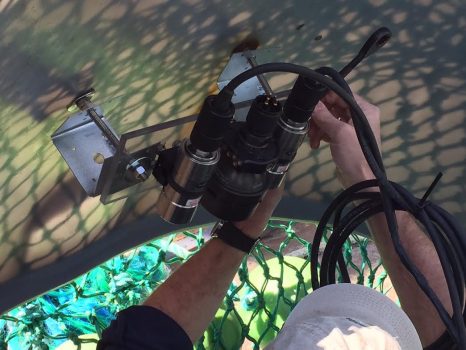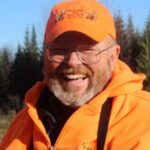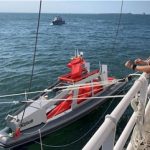Tag Archives: Jon Hare

Coronavirus: LI fishermen concerned about restart of onboard monitoring program
Some fishermen in Montauk this week said they plan to refuse to allow the federally mandated observers and monitors to board their boats, given the resurgence of COVID-19 around the country and the uncertainty around potential infection from observers, some of whom are housed in Hampton Bays, once considered a Long Island hot spot for the virus. The federal agency ordering the resumption of monitoring said it has enacted a series of safety protocols to protect fishermen and observers, including requiring that observers quarantine for 14 days before the start of a fishing trip. >click to read< 17:14

Update on Fishery Observer Program Restart, Which Resumes July 1st
On May 29, NOAA Fisheries announced that on July 1, the waiver of fishery monitoring will expire, and we will begin deploying observers and at-sea monitors on vessels fishing in northeast fisheries. In a letter released today, Northeast Fisheries Science Center Director Jon Hare is providing an update on preparations for a safe and efficient redeployment. For more details and to download the letter, >click to read< 18:30

Maine lobstermen tell federal regulators: We’re not killing the whales
The Maine Lobstering Union accuses the agency of caving to environmental organizations when it should be defending the industry. Kristan Porter, a Cutler lobsterman who heads up the Maine Lobstermen’s Association, said the modeling tool the agency had come up with to determine risk had been sharply criticized by a team of independent scientists during a peer review conducted late last year. Stonington lobsterman Julie Eaton urged regulators to stop playing dangerous games with fishermen’s lives and livelihoods. We don’t want to see any animal go extinct, but blaming us for the right whale’s decline is like blaming Mexico for the plight of the polar bear, she said. >click to read< 09:47

Troubling questions, concerns raised about off-shore wind farms
Oceanographer Jon Hare listed the effects of offshore wind development on the marine environment. There’s disturbance to the sea floor during installation of turbine platforms.,,,“Putting a pile into the sediment in essence is habitat alteration,” said Hare, a science and research director with Northeast Fisheries Science Center.,,The questions about offshore wind, of course, aren’t limited to the $2.8-billion Vineyard Wind project,,,,but there are more than a dozen proposals in the works all along the Atlantic Coast and plans for the Great Lakes and the West Coast. >click to read< 21:06

The best available science? – Backing lobstermen, Rep. Golden seeks to withhold funds for right whale protections
“The federal government is asking Maine lobstermen to make huge sacrifices without clear evidence that those sacrifices will have any positive impact on right whales,” Golden wrote in a statement Wednesday. “I’ve joined lobstermen to voice our concerns and now it’s time for action. Golden said it is important to help the right whale, but he joined the Maine lobster industry and Maine’s fishing managers in a common refrain: the federal government has no conclusive proof that right whales are getting hurt or killed by entanglement in Maine lobster gear. >click to read> 09:46

DON CUDDY: Whales, fish stocks and new tech: Catching up with NOAA’s Jon Hare
I was pleased to enjoy a wide-ranging chat with Mr. Jon Hare last week. Jon is the Science and Research Director for NOAA’s Northeast Fisheries Science Center in Woods Hole. That’s the division of NOAA that is charged with managing “the living marine resources of the Northeast Continental Shelf Ecosystem from the Gulf of Maine to Cape Hatteras.” So this man has a lot on his plate. When he began working as director in 2017 I interviewed him about the task ahead and did a follow up last year. So in what has now become an annual event we sat down to talk about how things are going at the Science Center and I found the encounter as interesting as ever. >click to read<18:40

Whale protection, trawl limits entangle Zone C lobstermen
October is a peak month, according to the state Department of Agriculture, Conservation and Forestry, for feistiness in Maine’s population of hornets and wasps. Lobstermen too, judging by last week’s meeting of the Zone C Lobster Management Council at Deer Isle-Stonington High School.,, While the trawl rule was at the forefront of last week’s debate, lurking just below the surface was a technical memorandum issued late last month by the NOAA Fisheries Northeast Fisheries Science Center. >click to read<11:49

Sam Parisi – Unless we have the science compared to an independent survey we are in peril at NOAA hands
I was reading an article in South Coast Today regarding the new director of NOAA Jon Hare who said quote, he is willing to talk to the fishermen. Among his duties at the Northeast Fishery Science Center, Mr. Hare is responsible for conducting the ground fish surveys that determine annual catch limits for each species. Fishermen have disagreed with NOAA findings and actually taken photo’s of thousand of lbs of cod caught in their nets. Up to now the vessel Bigelow has done NOAA surveys but now is dockside for repairs, and in it’s place is the Pisces that will only conduct a thirty day survey instead of sixty. click here to read the story 15:43

New NOAA Director seems willing to work with fishing industry
Jon Hare has just completed his first twelve months on the job as a science and research director or NOAA’s Northeast Fisheries Science Center in Woods Hole. And its a big job. But he’s still smiling. The NEFSC managers the living marine resources of the Northeast Continental Shelf Ecosystem from the Gulf of Maine to Cap Hatteras. But Hare’s energy and enthusiasm have been equal to the task, while his willingness to listen and engage with all comers have earned him respect within NOAA and in the larger community. It’s been a challenge but one that I’ve enjoyed,” he said, sitting don for a wide-ranging discussion at the Fishing Partnership office in New Bedford last week. click here to read the story 21:46

Live Cam May Show True Status of Atlantic Cod Fishery
Atlantic cod, New England’s most iconic fish, has been reported at historic lows for years, but fishermen hope a new video monitoring technique will prove there are more of the fish than federal surveyors believe. Ronnie Borjeson, who has been fishing for more than 40 years, says the federal surveys don’t match up with what fishermen are seeing. “I don’t care if you’re a gillnetter, a hook and line guy, a trawl guy,” he said, “there’s codfish everywhere up there. Everywhere. You can’t get away from them.” Borjeson helped test a video rig designed by researchers at the University of Massachusetts Dartmouth that allows them to record fish underwater and count them on the video later. With this rig, scientists can sample a larger area in the same amount of time and hopefully improve federal estimates of how many cod are left. click here to read the story 16:26
Counting Fish – A film by Don Cuddy click here to watch

Something fishy in the quotas?
The clatter reverberated in the refrigerated cold as workers offloaded fish and wheeled full bins into a storage area on Fisherman’s Wharf. The catch was sorted, weighed, labeled, and eventually loaded onto large trucks headed for New York. It was a big haul, but not a big payday for Tom Testaverde Jr., captain of the Midnight Sun. “Our season’s been good. We caught a lot of fish, but the prices have been killing us all year,” Testaverde said. He pointed to imports that drive prices down, and regulations that limit what kinds of fish he can catch. Those federal limits on some species — particularly groundfish such as cod and flounder — are at odds with what commercial fishermen say they are seeing in the ocean. click here to read the story 14:34
Northeast Fisheries Science Center director steers a new course
It was last Halloween when Jon Hare took over as Science and Research Director for NOAA’s Northeast Fisheries Science Center in Woods Hole. He was aware he was jumping into a cauldron but it hasn’t spooked him yet. “I knew it was going to be a challenge and that’s why I was interested in it,” the career NOAA scientist said. Hare does understatement well. The director’s job description includes managing “the living marine resources of the Northeast Continental Shelf Ecosystem from the Gulf of Maine to Cape Hatteras,” according to the NOAA website. If that in itself were not sufficient, these resources include commercial fisheries, and in New England that is synonymous with controversy. Federal fishery management in general, and the efficacy of NOAA’s survey work on fish stocks in particular, have been heavily criticized by fishermen in the Northeast, almost without cessation for the past 15 years and the NEFSC has been at the sharp end of much of this disaffection. Read the story here 20:22
took over as Science and Research Director for NOAA’s Northeast Fisheries Science Center in Woods Hole. He was aware he was jumping into a cauldron but it hasn’t spooked him yet. “I knew it was going to be a challenge and that’s why I was interested in it,” the career NOAA scientist said. Hare does understatement well. The director’s job description includes managing “the living marine resources of the Northeast Continental Shelf Ecosystem from the Gulf of Maine to Cape Hatteras,” according to the NOAA website. If that in itself were not sufficient, these resources include commercial fisheries, and in New England that is synonymous with controversy. Federal fishery management in general, and the efficacy of NOAA’s survey work on fish stocks in particular, have been heavily criticized by fishermen in the Northeast, almost without cessation for the past 15 years and the NEFSC has been at the sharp end of much of this disaffection. Read the story here 20:22
In Chesapeake Bay’s changing ecosystem, blue crab is king (and moving north)
 In the face of an evolving ecosystem, experts agree many of the differences in Chesapeake Bay marine life can – at least in part – be attributed to a worldwide warming trend. Over the last three decades, water temperatures in the Chesapeake Bay have increased about 1.5 degrees Celsius, or about 2.7 degrees Fahrenheit, said Rom Lipcius, professor of marine science at the Virginia Institute of Marine Science. The change means populations of many native sea creatures in the Chesapeake have moved or expanded north in search of cooler water temperatures, and other non-native creatures have moved in. As the warming trend continues, experts say some marine species will thrive as others struggle to survive in the face of temperature, environment and predator and prey changes. “It’s not all bad news, and it’s not all good news,” said Jon Hare, science and research director for the National Oceanic and Atmospheric Administration’s Northeast Fisheries Science Center. “There are both winners and losers in this situation.” There have been a number of species, including blue crab, scup and black sea bass, that have shifted or extended northward along the Atlantic coast, said Hare. Read the story here 08:35
In the face of an evolving ecosystem, experts agree many of the differences in Chesapeake Bay marine life can – at least in part – be attributed to a worldwide warming trend. Over the last three decades, water temperatures in the Chesapeake Bay have increased about 1.5 degrees Celsius, or about 2.7 degrees Fahrenheit, said Rom Lipcius, professor of marine science at the Virginia Institute of Marine Science. The change means populations of many native sea creatures in the Chesapeake have moved or expanded north in search of cooler water temperatures, and other non-native creatures have moved in. As the warming trend continues, experts say some marine species will thrive as others struggle to survive in the face of temperature, environment and predator and prey changes. “It’s not all bad news, and it’s not all good news,” said Jon Hare, science and research director for the National Oceanic and Atmospheric Administration’s Northeast Fisheries Science Center. “There are both winners and losers in this situation.” There have been a number of species, including blue crab, scup and black sea bass, that have shifted or extended northward along the Atlantic coast, said Hare. Read the story here 08:35
Warming ocean may bring major changes for US northeast fishery species
 NOAA scientists have released the first multispecies assessment of just how vulnerable U.S. marine fish and invertebrate species are to the effects of climate change. The study examined 82 species that occur off the Northeastern U.S., where ocean warming is occurring rapidly. Researchers found that most species evaluated will be affected, and that some are likely to be more resilient to changing ocean conditions than others. “Our method identifies specific attributes that influence marine fish and invertebrate resilience to the effects of a warming ocean and characterizes risks posed to individual species,” said Jon Hare, a fisheries oceanographer at NOAA Fisheries’ Northeast Fisheries Science Center (NEFSC) and lead author of the study. Read the article here 20:00
NOAA scientists have released the first multispecies assessment of just how vulnerable U.S. marine fish and invertebrate species are to the effects of climate change. The study examined 82 species that occur off the Northeastern U.S., where ocean warming is occurring rapidly. Researchers found that most species evaluated will be affected, and that some are likely to be more resilient to changing ocean conditions than others. “Our method identifies specific attributes that influence marine fish and invertebrate resilience to the effects of a warming ocean and characterizes risks posed to individual species,” said Jon Hare, a fisheries oceanographer at NOAA Fisheries’ Northeast Fisheries Science Center (NEFSC) and lead author of the study. Read the article here 20:00















































